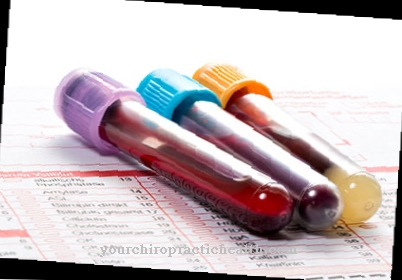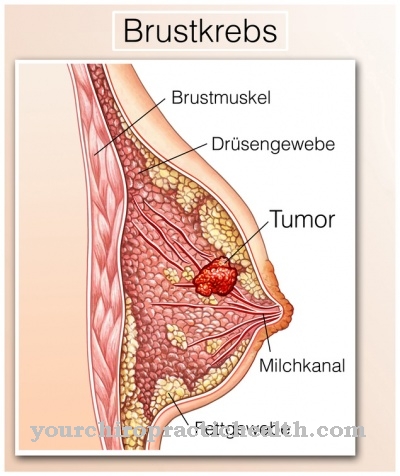If muscle weakness increases in adulthood, a neurologist should be consulted for a myotonic dystrophy type 2 to exclude. This is especially true if there are additional complaints such as cardiac arrhythmias or thyroid disorders. Other synonyms for this disease are: PROMM, DM2 and Ricker's disease.
What is myotonic dystrophy type 2?

© iokuukan - stock.adobe.com
The myotonic dystrophy type 2 has a number of alternative names, but they apply to the same disease. Next to the acronym DM2 are the terms in literature proxymal myotonic myopathy (PROMM) or Ricker's disease used.
It is a rare disease that has been known in Germany for about 12 years and was first described by Professor Kenneth Ricker. The disease is characterized by muscle weakness that occurs with delayed relaxation of the thigh and hand muscles after previous tension.
The muscle weakness is slowly progressing and especially pronounced in the pelvic girdle and shoulder area. Many patients experience pulling muscle pain, especially when climbing stairs or when getting up. A number of other complaints can also occur with type 2 myotonic dystrophy. These include cataracts and diseases of the heart muscle, but also disorders of thyroid function, as well as diabetes and impaired fertility.
causes
The cause of the Type 2 myotonic dystrophy is a genetic defect on the third chromosome. The sequences of the four bases are repeated here more strongly than in the normal case. Inheritance is autosomal dominant, whereby half of the children in an affected parent inherit the genetic defect, while the other half receives the healthy genetic makeup.
The disease occurs between the ages of 16 and 50. In contrast to type 1 of this disease, type 2 myotonic dystrophy does not worsen the symptoms from one generation to the next.
Symptoms, ailments & signs
Myotonic dystrophy type 2 is characterized by symptoms similar to myotonic dystrophy type 1. The main feature is the greatly delayed muscle relaxation in old age. This manifests itself in an increasing [[stiffness of the joints (joint stiffness) and weakness of the muscles. There are disturbed movements and muscle pain.
A cataract is also very common as part of the disease. The risk of developing diabetes mellitus is greatly increased. Cardiac arrhythmias are also very often observed. Since testosterone levels are too low, testicular atrophy can also occur. The ability to walk is usually only impaired in old age. #
Overall, the course of myotonic dystrophy type 2 is much more benign than that of myotonic dystrophy type 1. Although it is a genetically determined disease, the first symptoms only begin in adulthood. There is no congenital form of the disease as in myotonic dystrophy type 1. Mental and physical development disorders do not occur.
Lens opacity and diabetes mellitus can often be diagnosed early on. In contrast to myotonic dystrophy type 1, there is no anticipation here either. This means that the inheritance of the disease does not lead to the symptoms being moved forward to earlier years of life. Instead of curing the disease, however, it is only possible to alleviate the symptoms.
Diagnosis & course
The diagnosis of Type 2 myotonic dystrophy is difficult and therefore requires an experienced neurologist.
After taking a medical history and a physical exam, an electromyogram (EMG) can provide initial evidence of the disease. If the first symptom is a cataract or a cardiac arrhythmia, the ophthalmologist or internist must refer the patient to the neurologist for further diagnostics.
A targeted genetic test can confirm the diagnosis of type 2 myotonic dystrophy, especially if there is a corresponding family history, before the onset of symptoms. This is a blood test that is paid for by health insurance. The course of the disease is very different. The later the first symptoms appear in the affected person, the slower the progression of type 2 myotonic dystrophy can be expected.
Complications
As a result of this disease, those affected suffer from various ailments that can make everyday life significantly more difficult. First and foremost, there is severe muscle wasting and pain in the muscles. These pains can also take the form of resting pains and lead to sleep problems at night and thus to depression or other psychological complaints.
Furthermore, the patient's resilience is significantly reduced and the lens of the eye becomes cloudy and thus possibly cataracts. The patient's everyday life is negatively influenced by the visual problems. Furthermore, the disease leads to heart problems, so that in the worst case the patient can die of cardiac death. The life expectancy of the person affected is significantly reduced by this disease.
Usually there are no further complications with the treatment. The discomfort in the eyes can be resolved relatively well and easily, so that those affected can see normally again. Other complaints are treated with the help of surgical interventions or various therapies. As a rule, there are no particular complaints either.
When should you go to the doctor?
A doctor's visit should take place as soon as there is a weakening of muscle strength. Low physical performance or a decrease in the ability to exercise are signs in the body of an existing illness. A doctor should be consulted as soon as the symptoms persist over a long period of time or increase in intensity. Muscle pain that is not based on short-term overuse or one-sided posture should be clarified by a doctor.
If the person concerned suffers from mobility disorders or if there are abnormalities in the general movement sequences, a doctor is required. Delays or peculiarities in an adolescent's development give cause for concern. A doctor's visit is necessary as soon as there are significant differences between the person concerned in direct comparison with the possibilities of a peer. A reduced ability to walk, unsteady gait or an increased risk of falls and accidents should be discussed with a doctor.
Irregular heartbeat and impaired vision are other signs of an existing health condition that need to be examined and treated. If normal sporting activities can no longer be carried out, consultation with a doctor is required. If, in addition to the physical discrepancies, there is also emotional stress, a visit to the doctor is also advisable. In the case of behavioral problems, mood swings or depressive tendencies, the person concerned needs medical help.
Treatment & Therapy
For the Type 2 myotonic dystrophy there is currently no direct drug therapy. The treatment is therefore based on the symptoms that arise and is intended to alleviate the impairments that occur.
This includes above all physiotherapy and other physiotherapeutic applications against muscular complaints as well as medication for the treatment of diabetes and possible thyroid diseases and cardiac arrhythmias.
Most patients are muscularly limited, as fine motor skills and sensations in the limbs do not deteriorate with this disease. There are also no impairments when chewing and swallowing. Cataracts can be eliminated by surgery, which is usually carried out on an outpatient basis.
Local anesthesia are not a problem for the patient. In the case of planned general anesthesia, however, the anesthetist must be informed about the existing myotonic dystrophy of type 2 in order to be able to select the medication accordingly during the anesthesia.
You can find your medication here
➔ Medicines for muscle painOutlook & forecast
The prognosis for myotonic dystrophy type 2 is mixed. The main problem appears to be that the disease cannot be cured. The cause is a genetic defect. Doctors can only try to relieve symptoms that arise. In contrast, the disease only occurs in old age. Muscle weakness is usually less pronounced than type 1 myotonic dystrophy.
According to the current state of knowledge, it is also not associated with mental restrictions. Fine motor skills are retained. Most signs can be turned off with appropriate therapy and physiotherapy. Myotonic dystrophy type 2 can contribute to a shortening of the lifespan. Often a heart problem is the trigger for an early death.
The disease is very rare. One person out of 100,000 people suffers from it. There is usually an accumulation in families. Type 2 myotonic dystrophy is inherited. The likelihood of a possible illness as a senior increases if the muscle weakness was also present in other family members. The best chances of long-term freedom from symptoms arise if myotonic dystrophy type 2 is treated early with suitable therapies.
prevention
Since the Type 2 myotonic dystrophy If it is a genetic disease, there are no direct preventive measures. However, if you have a family history, genetic testing for this condition should be considered as it can be inherited. Possible complaints of type 2 myotonic dystrophy can be identified and treated in a more targeted manner through a reliable diagnosis. Thanks to the clear diagnosis, the patient can also better deal with the sometimes diffuse symptoms.
Aftercare
Follow-up care is not possible for type 2 myotonic dystrophy. The disease cannot be treated and those affected can only go to inpatient treatment. During these inpatient stays, the patients should learn how to maintain as much independence as possible despite their physical limitations.
Outpatient therapy and inpatient rehabilitation are adapted to the individual symptoms of the patient. With patient therapy and occupational therapy exercises, patients train their muscles in order to maintain their mobility for as long as possible. Speech therapists should help those affected to improve their language or to learn it again. Because the disease can in many cases also trigger mental illnesses such as depression, psychologists and social workers are available for the patients.
The scope of the exercises depends on the physical and mental condition. It is difficult to precisely match the correct physical load. On the one hand, muscles and joints should be trained. In the other way, however, patients must not overexert themselves in order not to worsen their symptoms.
Inpatient stays usually last between four and six weeks. Afterwards, the patients can receive regular physiotherapy or occupational therapy in their area. However, it is also possible to repeat the inpatient stay.
You can do that yourself
In the case of the disease, self-help is mainly aimed at improving the existing quality of life. This primarily includes maintaining mobility, independence and manpower. Through physiotherapy, those affected can maintain and improve the functions of individual muscles and specifically strengthen the muscles. In the case of swallowing or speech disorders, a speech therapist can use targeted exercises to alleviate the symptoms and relieve the suffering. In the event of problems with fine motor skills, occupational therapists help with targeted exercises to improve them again or to compensate for them with substitute movements.
Since it is a genetic disease, it is important to inform your relatives about possible symptoms which can be excluded or diagnosed by means of a genetic test
Some medications can make the condition worse. It is therefore helpful to have a muscle emergency card with you. This can be requested, for example, from the German Society for Muscle Diseases. This can be actively shown to new doctors and helps passively in the event of an accident, as the rescue service receives all the necessary information and informs the treating doctors. In the case of general anesthesia in particular, the anesthetist must be careful and use compatible therapeutic agents.
The progression of the disease can lead to mood swings or even depression, which can be treated as part of psychotherapy.



.jpg)
.jpg)

.jpg)




















